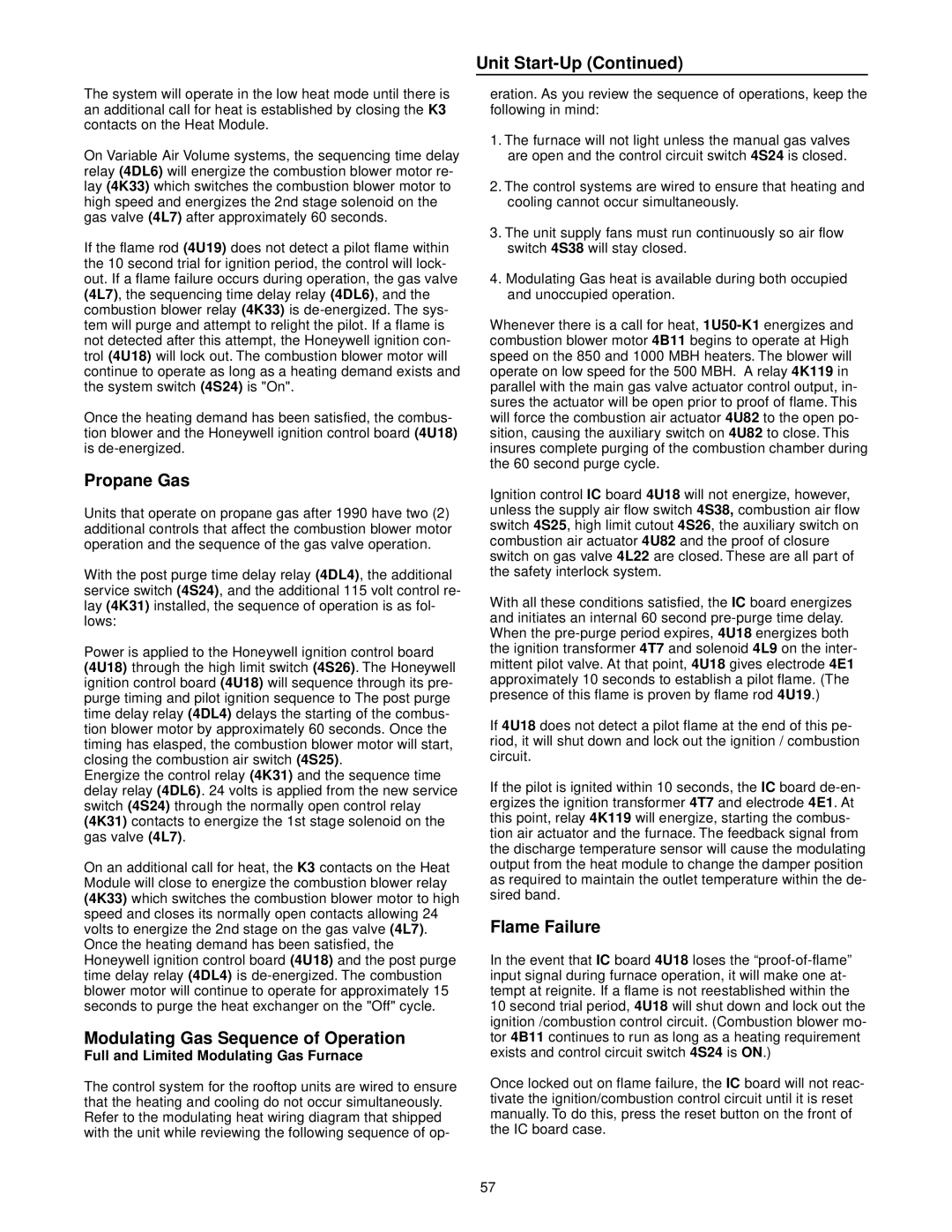The system will operate in the low heat mode until there is an additional call for heat is established by closing the K3 contacts on the Heat Module.
On Variable Air Volume systems, the sequencing time delay relay (4DL6) will energize the combustion blower motor re- lay (4K33) which switches the combustion blower motor to high speed and energizes the 2nd stage solenoid on the gas valve (4L7) after approximately 60 seconds.
If the flame rod (4U19) does not detect a pilot flame within the 10 second trial for ignition period, the control will lock- out. If a flame failure occurs during operation, the gas valve (4L7), the sequencing time delay relay (4DL6), and the combustion blower relay (4K33) is
Once the heating demand has been satisfied, the combus- tion blower and the Honeywell ignition control board (4U18) is
Propane Gas
Units that operate on propane gas after 1990 have two (2) additional controls that affect the combustion blower motor operation and the sequence of the gas valve operation.
With the post purge time delay relay (4DL4), the additional service switch (4S24), and the additional 115 volt control re- lay (4K31) installed, the sequence of operation is as fol- lows:
Power is applied to the Honeywell ignition control board (4U18) through the high limit switch (4S26). The Honeywell ignition control board (4U18) will sequence through its pre- purge timing and pilot ignition sequence to The post purge time delay relay (4DL4) delays the starting of the combus- tion blower motor by approximately 60 seconds. Once the timing has elasped, the combustion blower motor will start, closing the combustion air switch (4S25).
Energize the control relay (4K31) and the sequence time delay relay (4DL6). 24 volts is applied from the new service switch (4S24) through the normally open control relay (4K31) contacts to energize the 1st stage solenoid on the gas valve (4L7).
On an additional call for heat, the K3 contacts on the Heat Module will close to energize the combustion blower relay (4K33) which switches the combustion blower motor to high speed and closes its normally open contacts allowing 24 volts to energize the 2nd stage on the gas valve (4L7). Once the heating demand has been satisfied, the Honeywell ignition control board (4U18) and the post purge time delay relay (4DL4) is
Modulating Gas Sequence of Operation
Full and Limited Modulating Gas Furnace
The control system for the rooftop units are wired to ensure that the heating and cooling do not occur simultaneously. Refer to the modulating heat wiring diagram that shipped with the unit while reviewing the following sequence of op-
Unit Start-Up (Continued)
eration. As you review the sequence of operations, keep the following in mind:
1.The furnace will not light unless the manual gas valves are open and the control circuit switch 4S24 is closed.
2.The control systems are wired to ensure that heating and cooling cannot occur simultaneously.
3.The unit supply fans must run continuously so air flow switch 4S38 will stay closed.
4.Modulating Gas heat is available during both occupied and unoccupied operation.
Whenever there is a call for heat,
Ignition control IC board 4U18 will not energize, however, unless the supply air flow switch 4S38, combustion air flow switch 4S25, high limit cutout 4S26, the auxiliary switch on combustion air actuator 4U82 and the proof of closure switch on gas valve 4L22 are closed. These are all part of the safety interlock system.
With all these conditions satisfied, the IC board energizes and initiates an internal 60 second
If 4U18 does not detect a pilot flame at the end of this pe- riod, it will shut down and lock out the ignition / combustion circuit.
If the pilot is ignited within 10 seconds, the IC board
Flame Failure
In the event that IC board 4U18 loses the
10 second trial period, 4U18 will shut down and lock out the ignition /combustion control circuit. (Combustion blower mo- tor 4B11 continues to run as long as a heating requirement exists and control circuit switch 4S24 is ON.)
Once locked out on flame failure, the IC board will not reac- tivate the ignition/combustion control circuit until it is reset manually. To do this, press the reset button on the front of the IC board case.
57
